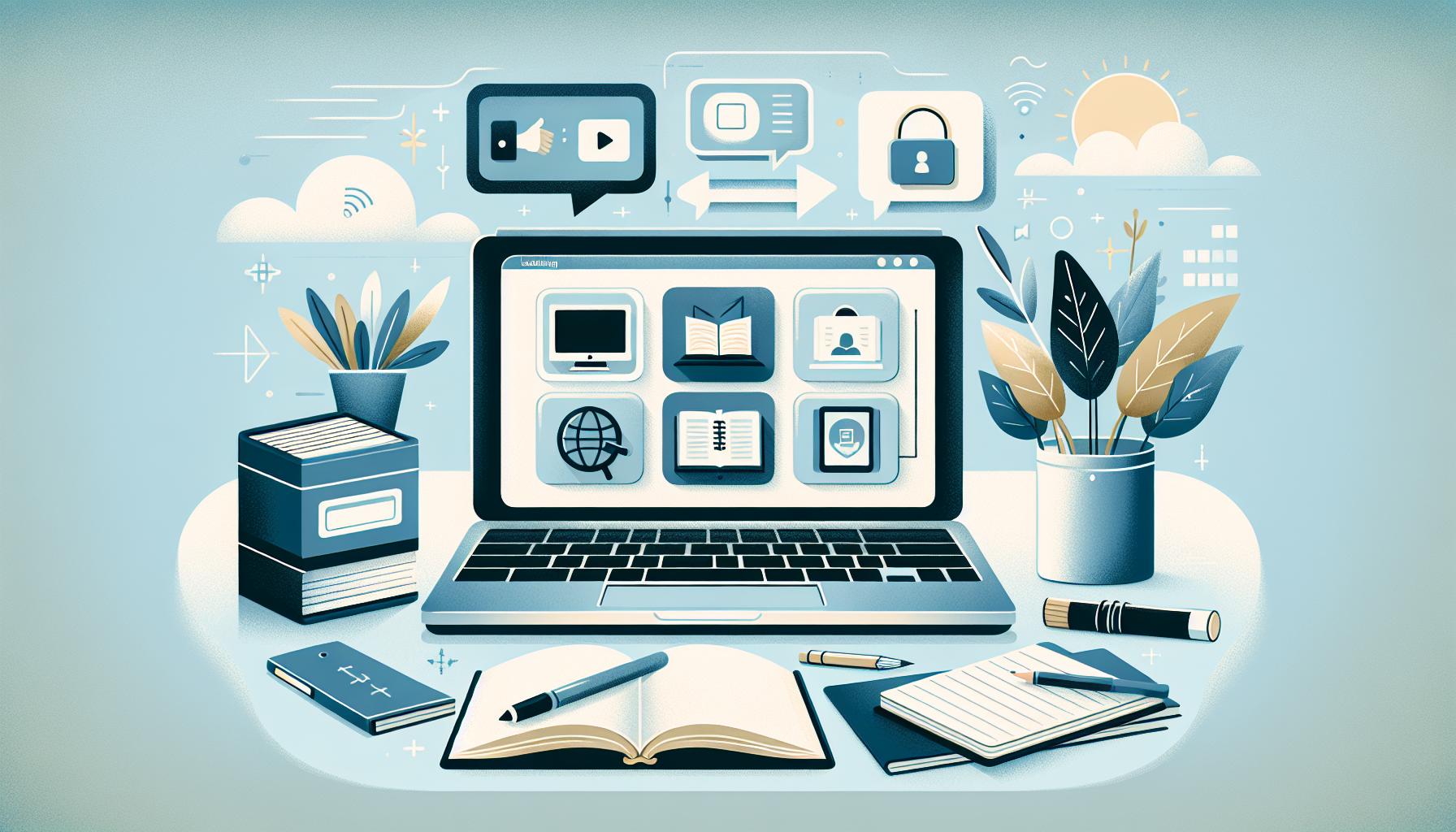Blended learning can seem a bit overwhelming, right? With so many teaching methods and technologies out there, it’s easy to feel lost. You’re not alone in thinking, “How do I make sense of all this?” It’s a common concern for educators navigating this new terrain.
But don’t worry! Stick around, and I’ll break down blended learning techniques in a way that feels easy and manageable. You’ll discover practical strategies that can enhance your teaching and keep your students engaged, making learning more fun for everyone.
We’ll cover everything from the basics of blended learning to the tools and trends that can help you succeed. By the end, you’ll have a toolkit ready to implement these innovative methods in your classroom. Let’s dive in!
Key Takeaways
- Blended learning combines traditional teaching with online methods, offering flexibility and engagement.
- Key techniques include flipped classrooms, learning stations, asynchronous learning, and adaptive technologies.
- Benefits of blended learning are increased student engagement, personalized experiences, and better resource allocation for teachers.
- Implement blended learning by assessing student needs, selecting appropriate tools, and providing training.
- Challenges include technology access, student isolation, data tracking, and the need for educator training.
- Future trends involve AI personalization, VR/AR experiences, a focus on student well-being, microlearning, and social learning platforms.

What is Blended Learning?
Blended learning is a mix of traditional face-to-face teaching and online instructional methods.
This approach allows students to learn at their own pace while also benefiting from personal interaction with their instructors and classmates.
For instance, a typical blended learning model might involve students attending lectures in person while completing supplementary online modules or assignments.
The beauty of blended learning is its flexibility; it can cater to various learning styles, which helps in keeping students engaged.
Imagine combining video lectures, online quizzes, and group discussions to make learning more vibrant and interesting.
Key Blended Learning Techniques
There are several techniques that educators can adopt in a blended learning environment to maximize its effectiveness.
First, the **flipped classroom** model has gained popularity—students watch lectures at home, freeing up class time for hands-on activities and discussions.
This shift allows for deeper engagement during face-to-face interactions.
Another technique is the use of **learning stations** where students rotate through different activities—some online, some offline—tailored to various skills or topics.
Similarly, **asynchronous learning**, where learners can access materials at their convenience, is incredibly useful for accommodating diverse schedules.
Finally, employing **adaptive learning technologies** can personalize education in real time, allowing students to progress at their own pace based on their individual performance.
Benefits of Blended Learning
Blended learning offers a host of benefits that make it an appealing option for modern education.
Firstly, it increases student engagement by allowing them to choose how and when they learn.
For example, students can replay video lectures if they find certain topics challenging.
Secondly, it promotes a more personalized learning experience; educators can use real-time data to identify struggling students and adapt their teaching strategies accordingly.
This data-driven approach not only helps in customizing training but also informs instructors of the effectiveness of different teaching methods.
In addition, blended learning often leads to better resource allocation, as teachers save time on administrative tasks and can focus more on student development and feedback loops.
Implementing Blended Learning in Classrooms
To successfully implement blended learning in classrooms, it’s essential to start with a robust plan.
Begin by assessing your students’ needs and outlining specific learning objectives that blend online and offline techniques effectively.
Next, choose appropriate digital tools and resources that align with your curriculum, such as platforms for hosting online materials or tools for creating quizzes.
It’s also important to provide training for both educators and students on how to use these tools effectively.
Encourage an open dialogue where students can express their thoughts about what works for them in these combined settings.
Finally, routinely assess both the students’ progress and the effectiveness of your blended approach, allowing for ongoing adjustments to improve the learning experience.

Tools and Resources for Blended Learning
Having the right tools and resources is crucial for a successful blended learning experience.
Start by exploring **Learning Management Systems (LMS)** like Moodle or Canvas, which offer everything from course materials to tracking student progress.
These platforms make it easy to upload lectures, assignments, and quizzes all in one place.
Another helpful tool is video conferencing software, such as Zoom or Microsoft Teams, allowing for real-time interaction even in virtual spaces.
Don’t forget about collaborative tools like Google Workspace or Microsoft 365, which facilitate teamwork and document sharing among students.
Additionally, consider integrating tools for creating interactive content, such as Kahoot! or Nearpod, to keep students engaged and motivated.
For assessment, platforms like Socrative and Quizlet can help design quizzes that provide immediate feedback.
Finally, ensure your resources are flexible and can cater to various learning styles, so every student has the chance to shine.
Challenges of Blended Learning
While blended learning offers numerous benefits, it’s not without its challenges.
One common issue is ensuring that all students have equal access to technology and the internet.
This digital divide can create disparities in learning opportunities; thus, schools should work to provide necessary resources for all students.
Another challenge is the potential for students to feel isolated, as the online components may reduce in-person interaction.
To combat this, encourage collaboration through group projects or discussion forums that foster communication among peers.
Additionally, teachers may need to gather extensive data to track student progress, which can be time-consuming.
Implementing efficient data collection methods and utilizing user-friendly software can help streamline this process.
Finally, transitioning into a blended learning environment may require substantial training for both educators and students, which can feel overwhelming.
Ongoing support and professional development opportunities can ease this transition and ensure everyone is on the same page.
Future Trends in Blended Learning
The landscape of blended learning is constantly evolving, driven by technological advancements and educational research.
One trend gaining traction is the use of **AI-driven personalized learning**, which tailors the educational experience to fit individual student needs.
Similarly, virtual reality (VR) and augmented reality (AR) are emerging as exciting ways to engage students in immersive learning experiences.
Imagine learning about history through a virtual tour of ancient civilizations—it’s engaging and informative!
Another trend is the increasing focus on student well-being and mental health in blended learning environments.
This includes designing course materials that reduce stress and promote a balanced approach to education.
Moreover, the rise of **microlearning**, where students engage with small, focused segments of content, is transforming how we approach lesson delivery.
This bite-sized information can be easily integrated into daily schedules and keeps learners invested.
Engagement through **social learning** is also on the rise, with platforms enabling students to interact and learn from each other, enhancing their educational journey.

Tools and Resources for Blended Learning
Having the right tools and resources is crucial for a successful blended learning experience.
Start by exploring Learning Management Systems (LMS), such as Moodle or Canvas, which offer everything from course materials to tracking student progress.
These platforms make it easy to upload lectures, assignments, and quizzes all in one place.
Another helpful tool is video conferencing software like Zoom or Microsoft Teams, allowing for real-time interaction even in virtual spaces.
Don’t forget about collaborative tools like Google Workspace or Microsoft 365, which facilitate teamwork and document sharing among students.
Additionally, consider integrating tools for creating interactive content such as Kahoot! or Nearpod, to keep students engaged and motivated.
For assessments, platforms like Socrative and Quizlet can help design quizzes that provide immediate feedback.
Finally, ensure your resources are flexible and can cater to various learning styles so that every student has the chance to shine.
Challenges of Blended Learning
While blended learning offers numerous benefits, it’s not without its challenges.
One common issue is ensuring that all students have equal access to technology and the internet.
This digital divide can create disparities in learning opportunities; thus, schools should work to provide necessary resources for all students.
Another challenge is the potential for students to feel isolated, as the online components may reduce in-person interaction.
To combat this, encourage collaboration through group projects or discussion forums that foster communication among peers.
Additionally, teachers may need to gather extensive data to track student progress, which can be time-consuming.
Implementing efficient data collection methods and utilizing user-friendly software can help streamline this process.
Finally, transitioning into a blended learning environment may require substantial training for both educators and students, which can feel overwhelming.
Ongoing support and professional development opportunities can ease this transition and ensure everyone is on the same page.
Future Trends in Blended Learning
The landscape of blended learning is constantly evolving, driven by technological advancements and educational research.
One trend gaining traction is the use of AI-driven personalized learning, which tailors the educational experience to fit individual student needs.
Similarly, virtual reality (VR) and augmented reality (AR) are emerging as exciting ways to engage students in immersive learning experiences.
Imagine learning about history through a virtual tour of ancient civilizations—it’s engaging and informative!
Another trend is the increasing focus on student well-being and mental health in blended learning environments.
This includes designing course materials that reduce stress and promote a balanced approach to education.
Moreover, the rise of microlearning, where students engage with small, focused segments of content, is transforming how we approach lesson delivery.
This bite-sized information can be easily integrated into daily schedules and keeps learners invested.
Engagement through social learning is also on the rise, with platforms enabling students to interact and learn from each other, enhancing their educational journey.
FAQs
The primary components of blended learning include a mix of in-person classroom instruction and online learning activities. It combines traditional teaching methods with digital resources to enhance the overall educational experience.
Blended learning offers personalized learning experiences, flexibility in pace, and improved access to resources. It encourages student engagement and collaboration while promoting the development of digital literacy essential for modern education.
Educators might encounter challenges such as insufficient training, unequal access to technology, and resistance from students or parents. Balancing online and face-to-face components can also be a logistical challenge to manage effectively.
Common tools include learning management systems (LMS) like Canvas or Moodle, video conferencing software like Zoom, educational apps, and digital assessment tools. These resources facilitate communication, content delivery, and progress tracking in a blended learning setting.
